Firewall Guidance
The Remote Desktop application is designed to be firewall friendly. In most cases, you simply need to permit the firewall prompts related to the Remote Desktop application during installation.
In case you need to configure the firewall permissions manually, allow the following TCP port numbers and executables.
| Server address | : | *.remotedesktop.com |
| Port number | : | 443 |
| Executables for Windows OS | : | RemoteDesktopViewerUI.exe RemoteDesktopUI.exe RemoteDesktopUIU.exe RemoteDesktopShortcut.exe RDDownloader.exe RDBSUtility.exe RemoteDesktopLauncher.exe RDFireWallRule.exe RDUtilityViewer.exe RDUtilityHost.exe RDFTViewer.exe RDFTHost.exe RDCmdViewer.exe RDCMDHost.exe RemoteDesktopBHS.exe RDPrinterDownloader.exe RDFileAccessHost.exe RDViewerHostKeyPopup.exe RDPreUninstall.exe RDFireWallRule.exe RDServiceMonitor.exe RDUILaunch.exe RDDND_Console.exe RDViewerService.exe RDHostService.exe RDKeyBoardMouseInputHandler.exe RDDnDLauncher.exe RemoteDesktopUSB.exe RDProxyLatency.exe RemoteDesktopClient.exe RemoteDesktopService.exe RemoteDesktopEngine.exe RDClipboard.exe RDBlackScreenApp.exe |
| Executables for Mac OS | ||
| Remote Access and Premium Plan | : | RemoteDesktop RDFileTransfer RDHostFileTransfer RDHostUtilityTransfer RDNote RemoteDesktopAgent RemoteDesktopCapture RemoteDesktopView RemoteDesktopChat RDViewerUtilityTransfer RemoteDesktopService RemoteDesktopHelper RDVersionUpdate RDCommandLine |
| Corporate Plan (Viewer) | : | RemoteDesktopViewer RemoteDesktopView RDFileTransfer RDViewerUtilityTransfer RemoteDesktopChat RemoteDesktopHelperViewer RDVersionUpdate |
| Corporate Plan (Host) | : | RemoteDesktopHost RDHostFileTransfer RDHostUtilityTransfer RDViewerUtilityTransfer RDNoteHost RemoteDesktopAgent RemoteDesktopCaptureHost RemoteDesktopChat RemoteDesktopServiceHost RemoteDesktopHelperHost RDVersionUpdate RDCommandLine |
Firewall configuration for network issues
A firewall may be blocking the network connection. Try the below troubleshooting steps to check if it works.
Windows
- Turn off the firewall.
- Go to 'Firewall & Network Protection' > Click on 'Domain Network' > Turn 'Windows Defender Firewall' to 'off'.
- Go to 'Firewall & Network Protection' > Click on 'Private Network' > Turn 'Windows Defender Firewall' to 'off'.
- Go to 'Firewall & Network Protection' > Click on 'Public Network' > Turn 'Windows Defender Firewall' to 'off'.
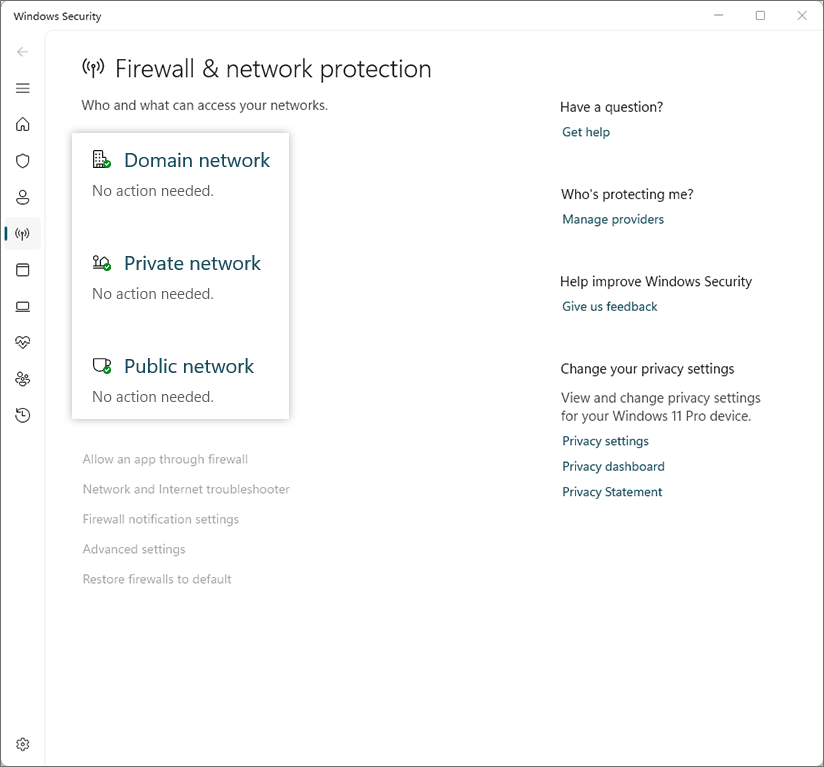
- Allow inbound connections in Windows firewall.
- Go to 'Windows defender firewall with advanced security' > 'Actions' > 'Properties' > 'Domain Profile' > 'Inbound connections', select 'Allow' in the dropdown list, and click 'Apply'.
- Go to 'Windows defender firewall with advanced security' > 'Actions' > 'Properties' > 'Private Profile' > 'Inbound connections', select 'Allow' in the dropdown list, and click 'Apply'.
- Go to 'Windows defender firewall with advanced security' > 'Actions' > 'Properties' > 'Public Profile' > 'Inbound connections', select 'Allow' in the dropdown list, and click 'Apply'.
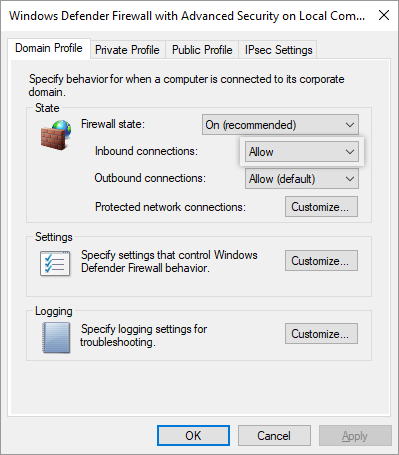
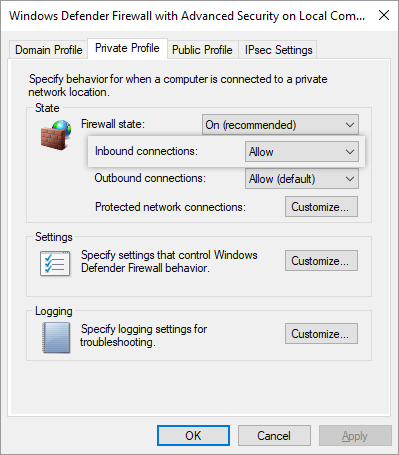
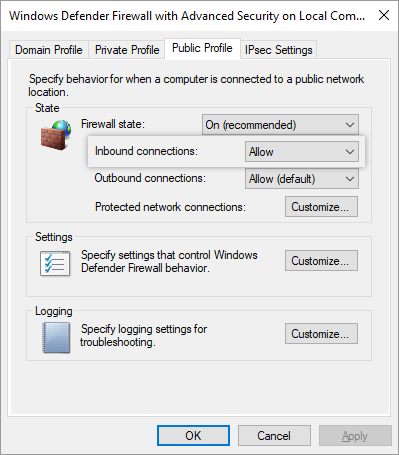
MAC
- Turn off the firewall.
- If you need to keep the firewall on, follow the steps below:
- 'System Preferences' > 'Security & Privacy' > 'Turn On Firewall' > 'Firewall Options…'.
- Uncheck 'Block all incoming connections'.
- Select 'Automatically allow signed software to receive incoming connections' checkbox.
- Click
 and select all the Remote Desktop exes / apps.
and select all the Remote Desktop exes / apps. - You may be prompted to allow 'RemoteDPCService' to access incoming network connections. Click 'Allow'.

This message might pop up after the first launch when the Remote Desktop app has been installed. Restart the computer to apply the modified firewall settings.
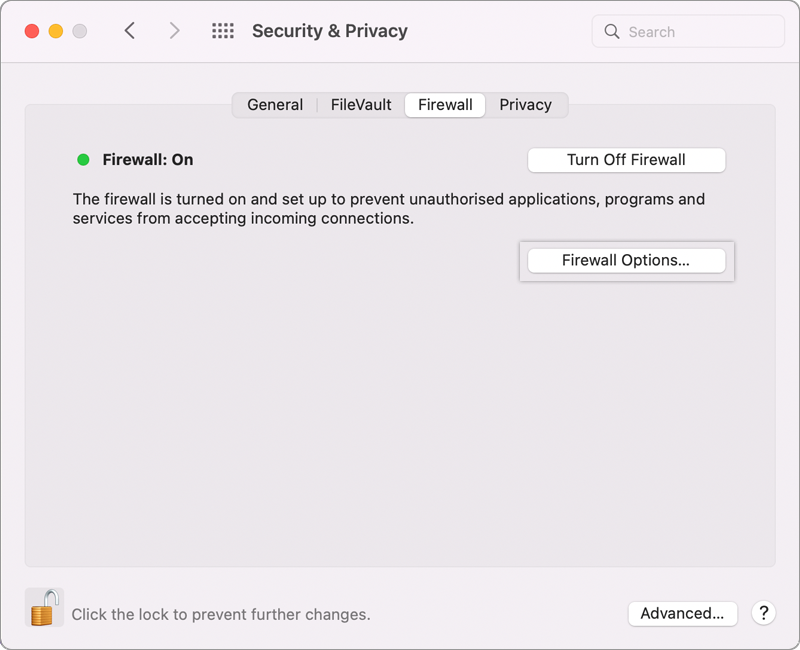
- Public IP might be blocked. Share your public IP with [email protected] to get it unblocked.
- Whitelist the IPs: Contact [email protected] to collect the IPs to whitelist.
- Add an exception to Norton firewall: link for reference.
- Add an exception to AVG firewall: link for reference.
In case the issue is still not resolved:

